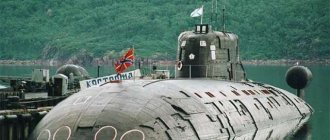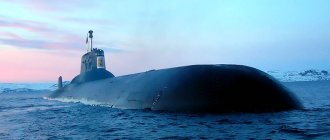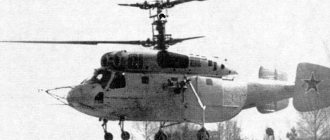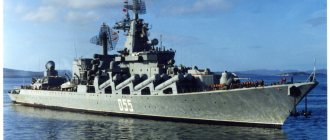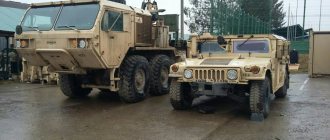This term has other meanings, see Antaeus (meanings).
| Project 949A Antey submarines | |
| K-186 "Omsk" | |
| Project | |
| A country |
|
| Manufacturers |
|
| Operators |
|
| Previous type | project 949 |
| Subsequent type | project 885 |
| Years of construction | since 1982 |
| Years in service | since 1986 |
| Planned | 18 |
| Built | 12 |
| Under construction | 1 (being completed according to project 09852) |
| In service | 8 |
| Canceled | 5 |
| Sent for scrapping | 2 |
| Losses | 1 |
| Main characteristics | |
| Displacement | 14,700 (surface) 23,900 t (submarine) |
| Length | 154 |
| Width | 18.2 m |
| Draft | 9.2 m |
| Power point | 2 × OK-650V |
| Power | 2 × 190 MW (thermal) 2 × 49,000 l. With. (GTZA) |
| Mover | 2 × fixed propeller |
| Travel speed | 15 knots (surface) 32 knots (submarine) |
| Working depth | 520 m[1] |
| Limit depth | 600 m[1] |
| Cruising range | not limited |
| Sailing autonomy | 120 days |
| Crew | 107 people |
| Armament | |
| Missile weapons | 12 twin anti-ship missiles 949A: 24 anti-ship missiles P-700 “Granit” 949AM: 72 anti-ship missiles P-800 “Oniks”, “Zircon”, “Caliber”. |
| Mine and torpedo weapons | 2 × 650 mm 4 × 533 mm TA (up to 28 torpedoes and missile-torpedoes in total) Air defense - MANPADS “Igla-1”, “Verba” |
| Media files on Wikimedia Commons | |
Project 949A Antey submarines,
according to NATO -
Oscar-II
- a series of Soviet and Russian nuclear-powered missile submarines of the 3rd generation, armed with 3M45 (P-700) cruise missiles. The project is an improved modification of Project 949 “Granite”.
Project[ | ]
The design assignment was issued in 1969. The development of Project 949 became a new stage in the development of APRC-class submarines, which, in accordance with the concept of asymmetric response, were entrusted with the task of countering aircraft carrier strike formations. The new missile submarines were supposed to replace the submarines of projects 659 and 675 and, in accordance with the technical specifications, surpassed them in all main parameters - they could launch missiles from both surface and submerged positions, had less noise, a higher underwater speed, three times more ammunition, missiles with radically improved combat capabilities. Project 949 became the pinnacle and end of the development of highly specialized submarines - “aircraft carrier killers”. Chief designer I. L. Baranov.
Modernization[ | ]
In December 2011, it became known that a modernization project had been developed at the Rubin Central Design Bureau. It is planned to replace the P-700 missiles with more modern P-800 Onyx or missiles from the Caliber family. It is planned to modify the launch containers without altering the hull. The modernization of the nuclear submarines of the Northern Fleet will be carried out at the Zvezdochka Center, and of the Pacific Fleet - at the Zvezda Shipyard[2].
History of Project 995 "Borey"
The history of the creation of fourth-generation Soviet submarines began back in 1978. Under the leadership of chief designer Zdornov, the Rubin Central Design Bureau began the development of Project 955 Borei (according to NATO classification “Dolgorukiy” or “Borei”) - a fourth-generation Soviet nuclear submarine. The new submarine was supposed to belong to the class of submarine missile carriers, have an underwater displacement of 29 thousand tons, a hull 170 meters long, an underwater speed of 29 knots and a diving depth of up to 400 meters.
Project 955 nuclear submarines were supposed to replace the obsolete ships 941 of the Akula project and 667 of the Dolphin BDRM. They planned to arm the boat with solid-fuel ballistic missiles; at first, the Bark missile was specially developed for this purpose, but it could not be brought to the stage of mass production, and it was decided to arm the new boats with R-30 Bulava missiles instead. Therefore, starting in 1998, Project 955 submarines were converted to a new missile system.
In general, it should be said that the fate of the Borey project was not easy. Initially, nuclear submarines were designed for one missile with certain dimensions, then the missile system was replaced. The main weapon of a strategic missile submarine is intercontinental ballistic missiles, and without them it will be like a weapon without projectiles. In 1998, they decided to abandon the creation of Bark missiles and a competition was announced for the development of a new solid-fuel rocket. The winner of the competition was the Moscow Institute of Heat Engineering.
The failures with the missile added to the overall difficult situation in the country in the late 90s. Budget funding practically stopped, construction of the first ship of the project was almost frozen. “Yuri Dolgoruky” at that moment consisted of disparate parts of the hull. Some materials and components were supplied from other republics of the USSR; after its collapse, supplies were stopped.
For example, special types of rolled metal were produced by the Zaporozhye Metallurgical Plant; after 1991, supplies ceased.
But despite all the difficulties, construction of the first boat of Project 955 “Borey” was resumed in 2000. The shipbuilders resorted to various tricks; even parts of the unfinished multi-purpose nuclear submarine K-337 Cougar were used. “Yuri Dolgoruky” was planned to be delivered in 2006, and in 2004 the second nuclear submarine of the same project, “Alexander Nevsky”, was laid down. In parallel with the construction of the boats, work was going on to create their weapon - a new solid-fuel rocket.
In 2005, the submarine's hull was completed, and in 2006, the third missile carrier of that project, Vladimir Monomakh, was laid down. In 2008, Yuri Dolgoruky was launched, its rector was launched, and the following year mooring and sea trials of the boat began. This submarine became the first Russian fourth-generation nuclear submarine project to be implemented.
Since 2003, the training of two crews for the first Project 955 nuclear submarine has been in full swing.
Construction[ | ]
Case[ | ]
The design is double-hulled, with a distance between the light and durable hull of 3.5 meters, which provides a significant reserve of buoyancy, up to 30%, and provides additional protection against underwater explosions. For their characteristic appearance they received the nickname “loaf”. The robust housing is divided into ten internal compartments[3].
Power plant[ | ]
The main power plant has a block design and includes two nuclear reactors of the OK-650B type and two steam turbines of the OK-9 type with a capacity of 98,000 hp. pp., working through gearboxes on propellers. Additionally, for auxiliary functions, Project 949 submarines are equipped with two diesel generators of the DG-190 type, the power of which is 8700 hp. With.
| This section is not completed. You will help the project by correcting and expanding it. |
Armament[ | ]
Anti-ship [ | ]
Main articles: P-700 "Granit"
,
P-800 “Oniks”
and
Caliber (cruise missile)
Throughout the middle compartments in the side containers outside the durable hull there are 24 3M45 missiles of the 3K45 complex (P-700 “Granit”), which are the main weapons of the boats. The containers are tilted forward from the vertical at an angle of 40-45° and are closed in pairs with twelve fairing lids that form part of the lightweight body.
By 2020, the upgraded Project 949AM Antey nuclear submarines will carry up to 72 Caliber or Onyx missiles[4][5], as well as Zircon anti-ship missiles[6].
Mine-torpedo[ | ]
Torpedo armament consists of six bow torpedo tubes: two 650 mm caliber and four 533 mm caliber. The ammunition includes 8-12 missile torpedoes and torpedoes of 650 mm caliber and 16 torpedoes of 533 mm caliber.
Combat and defensive weapons
Almost all of the ship's armament requires expensive modernization, which was one of the reasons for its decommissioning.
The Kirov nuclear cruiser's armament is designed primarily for enemy surface ships
Attention is also paid to anti-submarine protection; three Ka-27PL helicopters play a key role in this matter. The ship's air defense is provided by anti-aircraft artillery
As a result, the ship is capable of actively defending itself and hitting air, surface, ground and underwater targets, both alone and as part of a group.
Anti-ship missile P-700 "Granit"
The Kirov is equipped with twenty P-700 Granit anti-ship missiles. This guided missile weapon (URL) is intended for large ships, including aircraft carriers, and is designed to hit targets at long distances. The use of missiles is based on satellite target designation, which makes it possible to adjust its course. This aspect ensures the accuracy of the hit. In addition to surface targets, missiles can also be used against ground targets.
SAM "Fort"
For air defense (air defense), the cruiser is equipped with 12 S-300F Fort installations. Each has eight drum-type launch tubes and is designed to engage high-speed, maneuverable and small targets at both low and high altitudes. The firing interval is 3 seconds, the ammunition load is 96 missiles.
SAM "Osa-M"
Additional air defense is provided by M-4 Osa-M anti-aircraft missile systems. There are two such installations, each designed to launch two missiles. Rate of fire - 2 rounds per minute, range - 15 km, height - 3.5-4 km. Ammunition - 40 missiles.
"Tor-M1"
The Tor-M1 anti-aircraft missile system, better known in the naval version as the Kinzhal air defense system, is installed on the Peter the Great ship of the same project 1144. Such weapons are not provided for the Kirov cruiser due to the refusal to further modernize the ship.
Anti-submarine weapons
Against submarines, the cruiser is equipped with a Metelitsa anti-submarine missile launcher, an RBU-6000 12-tube rocket launcher and two six-barreled RBU-1000 Smerch-3. These installations provide protection for the ship against torpedo attacks. For retaliatory measures there are 10 torpedo tubes of 533 mm caliber.
Additionally, there are three Ka-27PL helicopters for anti-submarine warfare. Their speed is 270 km/h, range is 800 km. Armed with guided depth charges and APR-2E anti-submarine missiles.
Artillery systems AK-630
AK-630 complexes belong to anti-aircraft artillery. The cruiser has 8 such installations, 6 30-caliber barrels each. They are used for self-defense; at a slant range they hit air targets within 4 km, ground or sea targets within 5 km. In addition to these systems, there are two AK-100 single-barrel artillery mounts.
Construction[ | ]
In 1982-1996, 11 ships out of 18 planned were built, one boat was lost, K-329 was being completed according to project 09852, the rest were dismantled on the slipway or cancelled.
Project representatives[ | ]
Table colors:
White -
not completed or disposed of without being launched
Green -
operating as part of the Russian Navy
Blue -
under repair or modernization
Red -
written off, scrapped or lost
| Name | Head No. | Pawned | Lowered | In service | Fleet | State | Notes |
| K-148 "Krasnodar" | 617 | 22.07.1982 | 03.03.1985 | 30.09.1986 | Served in the Northern Fleet, dismantled in 2014 | ||
| K-173 "Krasnoyarsk" | 618 | 04.08.1983 | 27.03.1986 | 31.12.1986 | Served at the Pacific Fleet, dismantled in 2020 | ||
| K-132 "Irkutsk" | 619 | 08.05.1985 | 29.12.1987 | 30.12.1988 | Pacific Fleet | Repair and modernization | Undergoing repairs and modernization at the Zvezda plant until 2022[7] |
| K-119 "Voronezh" | 636 | 25.02.1986 | 16.12.1988 | 29.12.1989 | SF | In service | In 2011, repairs at the Zvezdochka Center were completed[8] |
| K-410 "Smolensk" | 637 | 09.12.1986 | 20.01.1990 | 22.12.1990 | SF | In service | In 2014, repairs were completed at the Zvezdochka Center[9] |
| K-442 "Chelyabinsk" | 638 | 21.05.1987 | 18.06.1990 | 28.12.1990 | Pacific Fleet | Repair and modernization | Undergoing repairs and modernization at the Zvezda plant[10] until 2022 |
| K-456 "Tver" | 649 | 09.02.1988 | 28.06.1991 | 18.08.1992 | Pacific Fleet | In service | Until 06/20/1996 “Kasatka”, until 01/28/2011 “Vilyuchinsk”. |
| K-266 "Eagle" | 650 | 19.01.1989 | 22.05.1992 | 30.12.1992 | SF | In service | In 2020, renovations at the Zvezdochka Center were completed[11] |
| K-186 "Omsk" | 651 | 13.07.1989 | 10.05.1993 | 15.12.1993 10.12.1993[12] | Pacific Fleet | In service | On June 29, 2020, after repairs, it was transferred to the Pacific Fleet[13] |
| K-141 "Kursk" | 662 | 22.03.1990 | 16.05.1994 | 20.01.1995 30.12.1994[12] | She served in the Northern Fleet, died on 08/12/2000 with her entire crew in the Barents Sea, was raised by 2002 and disposed of by 2004. | ||
| K-150 "Tomsk" | 663 | 27.08.1991 | 20.07.1996 | 30.12.1996 | Pacific Fleet | In service | In 2014, repairs were completed at the Zvezda plant [14] |
| K-329 "Belgorod"[12] | 664 | 24.07.1992 20.12.2012 | 23.04.2019 | 12.2021[15] | SF | Mooring tests | It is being built according to a special project. Will become the carrier of the POSIDN project "Poseidon"[16] |
| K-135 "Volgograd" | 675 | 02.09.1993 | Not completed | In 1998, it was discontinued and mothballed. In 2012 it was dismantled for metal. | |||
| K-160 "Barnaul" | 676 | n/a | Readiness for 2002 was 49%. In 2012 it was dismantled for metal. | ||||
| TO-? | 677 | n/a | Laid out according to project 949U[17] | ||||
| TO-? | 678 | n/a | |||||
| TO-? | 679 | n/a | |||||
| TO-? | was not mortgaged | ||||||
APL 949 device
Submarines of the Antey type have a double-hull design: a lightweight outer hydrodynamic cylindrical hull surrounds an inner one, which differs from the outer one in its high strength. The thickness of its walls exceeds 6 cm. Due to this double-hull architecture, nuclear submarines have the following advantages:
- Submarines are provided with high buoyancy.
- Nuclear submarines are protected from underwater explosions.
- Submarines have increased displacement.
The hull of nuclear submarines consists of the following departments:
- Torpedo.
- Managerial.
- Compartments for combat posts and radio room.
- Residential premises.
- Department for electrical equipment and auxiliary mechanisms.
- Reactor.
- GTZA Department.
- Compartment with rowing electric motors.
In the event of an accident, a nuclear submarine is equipped with two zones (bow and stern) in which the crew can wait for rescue. The crew consists of 130 people. According to other data, the number does not exceed 112. The submarine can remain in autonomous mode for no more than 120 days.
Comparative assessment[ | ]
Project 949A Antey submarines are the largest class of ships armed with P-700 missiles; ships of this class are also leaders in the number of Granit launchers on one carrier.
Currently, Project 949A submarines, together with TU-22M3 bombers of the Russian Navy, are the main means of countering the Russian Navy against carrier strike groups of the US Navy. The cost of the nuclear submarine was 226 million rubles in the mid-1980s - about 10% of the cost of the Nimitz aircraft carrier. At the same time, the US Navy currently has at least 11 nuclear-powered aircraft carriers, currently only 3 serviceable aircraft carriers are in service, while only 6 serviceable Project 949A nuclear submarines are in service.
Description of the design of TARK project 1144 "Kirov"
Ships of Project 1144 "Orlan"
Despite the significant displacement, the well-thought-out design of the ship, including the extended forecastle, provides the vessel with optimal performance. For all ships of the project, the design characteristics remain common, but there are also certain differences in the indicators.
Layout
The layout of the cruiser "Kirov" includes about 1,600 rooms located in the hull and superstructures. Of these, about 140 are cabins for officers with one, two and four places. For sailors and foremen there are 32 cockpits with 8-34 seats each.
For the convenience of the crew, there are 30 showers, two baths, a sauna with a 4x3 pool. The two-tier medical block includes isolation hospitals, a pharmacy, an X-ray and dental office, an outpatient clinic and an operating room. The length of all passages, vestibules and compartments is about 20 km.
Displacement and dimensions, weight
In terms of dimensions, the nuclear-powered cruiser Kirov has the following technical characteristics:
- length - 252 m, waterline - 230 m;
- width - 28.5 m;
- draft - 9.1 m.
Bow and stern
The bow of the vessel is made as standard for a warship and has a sharp stem. Ahead of the cruiser is the antenna of the Polynom hydroacoustic complex. Also at the front is the ship's main missile armament. Transom stern. The space of the vessel behind the superstructures is reserved for helipads and artillery. There are also fuel tanks and hangar lifts here.
Armor and torpedo protection
The cruiser Kirov has standard hull armor for Project 1144 ships. Additional protection is provided by the layout of the premises - the key ones are located in the depths of the ship.
Anti-torpedo protection has two components: reinforced armor and hull duplication. The thickening of the armor is made one meter below the waterline and two above. The cruiser does not have belt armor; key areas are protected separately. Additional armor is provided for Granit anti-ship missile silos, information and command post, engine room, helicopter hangar, fuel tanks, and ammunition depots.
Crew
The ship's crew consisted of 727 people, including 97 officers. The first commander of the ship in 1976-84 was A. S. Kovalchuk. The ninth and last in 2005-10 was A. L. Chernenko.
Notes[ | ]
- ↑ 12
Project 949A - Nuclear submarines of the Antey project will undergo rearmament (unspecified)
(December 12, 2011). Retrieved December 12, 2011. - Nuclear submarine "Kursk": from creation to tragedy // rian.ru, 08/13/2008
- Reedus
.
Antey nuclear submarines are being upgraded to the level of supersonic killers (Russian), Reedus
. Retrieved April 3, 2020. - The total ammunition capacity of the Antey nuclear submarine will triple (unspecified)
. Military-industrial courier (March 28, 2017). Retrieved July 9, 2020. - Weapons and equipment – Naked Science (undefined)
. naked-science.ru. Retrieved September 17, 2020. - By 2025, the Russian Ministry of Defense intends to modernize 4 nuclear submarines for the Pacific Fleet
- (unspecified)
was launched in Severodvinsk . Lenta.ru (May 26, 2009). Retrieved August 14, 2010. - The nuclear-powered icebreaker "Smolensk" will visit the North Pole in 2014 // KP.RU
- Three nuclear submarines will leave Kamchatka for repairs at once
- Nuclear-powered submarine missile cruiser "Eagle" returned to the Navy after repairs
- ↑ 123
SSGN project 949, 949A and 949U on russianships.info - The modernized nuclear submarine missile cruiser "Omsk" was transferred to the Pacific Fleet as part of the Army-2019 forum.
- On the eve of Victory Day, a memorial plaque dedicated to the nuclear submarine "Tomsk" was unveiled
- Another year and a half: the Poseidon carrier is undergoing testing (Russian). Gazeta.Ru
. Retrieved June 10, 2020. - Source: the first carrier of Poseidons will be the special submarine Belgorod
- Cruising submarines (undefined)
.
RussianShips.info
. Retrieved July 9, 2020.
Characteristics
| Ship type | SSGN |
| Project designation | 885 "Ash" |
| Speed (surface), knots | 16 |
| Speed (underwater), knots | 31 |
| Working immersion depth, m | 520 |
| Max. immersion depth, m | 600 |
| Navigation autonomy, days. | 100 |
| Crew, people | 64 |
| Dimensions | |
| Surface displacement, t | 8 600 |
| Underwater displacement, t | 13 800 |
| Length max., m | 139,2 |
| Hull width max., m | 13 |
| Average draft, m | 9,4 |
| Power point | Water-cooled reactor OK-650V |
| Armament | |
| Torpedo and mine weapons | Ten 533 mm torpedo tubes. USET-80 torpedoes, and in the future - Fizik and Futlyar thermal homing torpedoes. |
| Missile weapons | 8x4 PU Onyx, Caliber and planned X-101 (X-102). |
https://youtube.com/watch?v=eCY_YE7PB8Y
https://youtube.com/watch?v=eCY_YE7PB8Y
Author of the article:
Egorov Dmitry
I am interested in military history, military equipment, weapons and other issues related to the army. I love the written word in all its forms.
Armament
Submarine armament
The armament of Project 941 submarines is divided into three categories:
- ballistic missiles;
- torpedoes;
- Air defense;
- radio-electronic systems.
D-19 ballistic missile systems are the submarine’s strategic weapons. For firing torpedoes (53-65K, SET-65, SAET-60M, USET-80) and missile torpedoes (Shkval, Vodopad), 6 launchers are provided, caliber - 533 mm. It is also possible to install minefields through them. The boat's air defense is provided by eight Igla-1 MANPADS.
Ballistic missile system D-19 class R-39 "Option"
The D-19 complex was developed specifically for Project 941 submarines. It consists of 20 R-39 Variant three-stage ballistic missiles. Given the size and weight of these projectiles, the Akula is the only type of submarine capable of carrying them on board.
All missiles can be launched in one salvo, with a short interval between individual launches. Firing is allowed from the surface, as well as from a depth of up to 55 m. Weather conditions do not affect launches. The shock-absorbing rocket launch system reduces the interval between launches and the level of noise produced.
